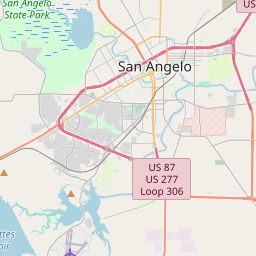First Presbyterian Church
Historical marker location:






The Presbytery of Central Texas sent the Rev. J. H. Zivley to San Angelo in 1885 to organize a church here. Seven communicants met with Zivley in the Methodist church building and founded the Southern Presbyterian Church of San Angelo. They included Mrs. A. J. Baker, Mrs. E. G.Burt, Mr. and Mrs. J. R. Burt, Mr. and Mrs. J. N. P. Cramer, and Mrs. Sally Hancock.
By 1886 the membership had grown to 27, and this land at the corner of Irving and College streets was purchased for $500. The first sanctuary was designed by architect Oscar Ruffini and finished in 1887. The Sunday School was instituted in the late 1890s with J. R. Burt as the first superintendent. Shortly after, the Ladies' Aid Society was formed with Mrs. A. J. Baker as its first president.
Construction of the present brick sanctuary began in 1906 and was completed in 1908. In that year a water-powered organ (since converted to electricity) was ordered from St. Louis by the Ladies' Aid Society. The sanctuary was dedicated in 1916.
An education building was built in 1950, and the fellowship hall was completed in 1956. During its first 100 years, the church was served by 11 ministers, two of whom served for a total of 63 years.
TEXAS SESQUICENTENNIAL 1826-1986
As one of the most visible programs of the Texas Historical Commission (THC), historical markers commemorate diverse topics in Texas history, including: the history and architecture of houses, commercial and public buildings, religious congregations, and military sites; events that changed the course of local and state history; and individuals who have made lasting contributions to the state, community organizations, and businesses.
Texas was once a part of Mexico but gained independence in 1836 after a famous battle at the Alamo.
In the late 1800s, the county began to attract settlers looking for opportunities in ranching and agriculture. This period saw an influx of farmers and ranchers who developed the land for cattle and sheep grazing, as well as growing crops such as cotton, corn, and wheat. The population increased significantly during this time, leading to the official organization of Tom Green County in 1874.
The county experienced rapid growth during the late 19th century, thanks to the establishment of Fort Concho and the expansion of the railroad. Fort Concho served as a primary military post protecting settlements against Native American raids and fostered economic growth by providing stability and resources to the region. Additionally, the arrival of the railroad in the 1880s further spurred economic development, making transportation of goods easier and stimulating trade.
In the early 20th century, Tom Green County faced several challenges, including droughts and the Great Depression. However, the county managed to overcome these obstacles and continued to thrive. Today, Tom Green County is known for its agriculture, oil and gas production, and as a center for healthcare and education. With a rich history that encompasses Native American heritage, frontier life, military significance, and economic growth, Tom Green County has played a vital role in the development of West Texas.
Tom Green County Timeline
This timeline provides a condensed summary of the historical journey of Tom Green County, Texas.
- 1874 - Tom Green County is organized and named after Confederate General Thomas Green.
- 1882 - The first courthouse in Tom Green County is built in the city of Ben Ficklin.
- 1884 - San Angelo becomes the county seat after a contentious election.
- 1886 - The Texas and Pacific Railway line is extended to San Angelo, boosting the city's economy.
- 1899 - San Angelo is incorporated as a city.
- 1928 - Goodfellow Air Force Base is established as a training facility during World War II.
- 1952 - Construction of the O.H. Ivie Reservoir begins on the Colorado River near San Angelo.
- 1995 - The San Angelo Museum of Fine Arts opens.
- 2002 - San Angelo experiences a devastating flood, causing significant damage to the city.
- 2015 - The San Angelo Stock Show and Rodeo celebrates its 83rd anniversary.